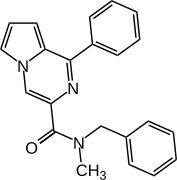 | |
| Identifiers | |
|---|---|
IUPAC name
| |
| CAS Number | |
| PubChem CID | |
| ChemSpider | |
| Chemical and physical data | |
| Formula | C22H19N3O |
| Molar mass | 341.414 g·mol |
| 3D model (JSmol) | |
SMILES
| |
InChI
| |
| (what is this?) (verify) | |
GML-1 is a TSPO (peripheral benzodiazepine receptor) ligand with anxiolytic activity. Its binding affinity (Ki value) to TSPO is comparable with PK11195. GML-1 is selective for TSPO versus the central benzodiazepine receptor (CBR, GABAA receptor). The compound GML-1 was the most active of a series of 1-arylpyrrolopyrazine-3-carboxamides, and its anxiolytic effects were examined using the open field test (OFT) and the elevated plus maze (EPM) test. The EPM test is a general anxiety test measuring the time spent by animals in the open or the enclosed arms. When compound was administered to CD-1 mice at the dose of 1.0 mg/kg, it significantly increased the percentage of open arm entries and the time spent in the open arms. GML-1 is a potential antianxiety agent.
The TSPO-mechanism of anxiolytic action of GML-1 was proved by inhibitor analysis with TSPO antagonist PK11195 that blocks effect of GML-1.
The involvement of neurosteroids in the mechanism of action of GML-1 was confirmed by co-administration of GML-1 with neurosteroid synthesis inhibitors. The anxiolytic effect of GML-1 in elevated plus-maze tests was completely blocked by the neurosteroidogenic-enzyme inhibitors trilostane and finasteride.
The tablet dosage form of GML-1 was developed and showed pronounced anxiolytic activity after intragastric administration in rats in a wide range of doses.
References
- ^ Mokrov GV, Deeva OA, Gudasheva TA, Yarkov SA, Yarkova MA, Seredenin SB (Jul 2015). "Design, synthesis and anxiolytic-like activity of 1-arylpyrrolopyrazine-3-carboxamides". Bioorganic & Medicinal Chemistry. 23 (13): 3368–78. doi:10.1016/j.bmc.2015.04.049. PMID 25937237.
- Yarkova MA, Mokrov GV, Gudasheva TA, Seredenin SB (Nov 2016). "Novel PyrroloPyrazines (TSPO Ligands) with Anxiolytic Activity Dependent on Neurosteroid Biosynthesis". Pharmaceutical Chemistry Journal. 50 (8): 501–4. doi:10.1007/s11094-016-1476-0. S2CID 35338758.
- Yarkova MA, Blynskaya EV, Yudina DV, Mokrov GV, Gudasheva TA, Alekseev KV (Jul 2019). "Development and Study of Anxiolytic Effect of GML-1 Tablet Dosage Form". Pharmaceutical Chemistry Journal. 53 (4): 342–346. doi:10.1007/s11094-019-02003-1. S2CID 195878442.
| Translocator protein modulators | |
|---|---|
| Agonists | |
| Antagonists | |
This article about an anxiolytic is a stub. You can help Misplaced Pages by expanding it. |